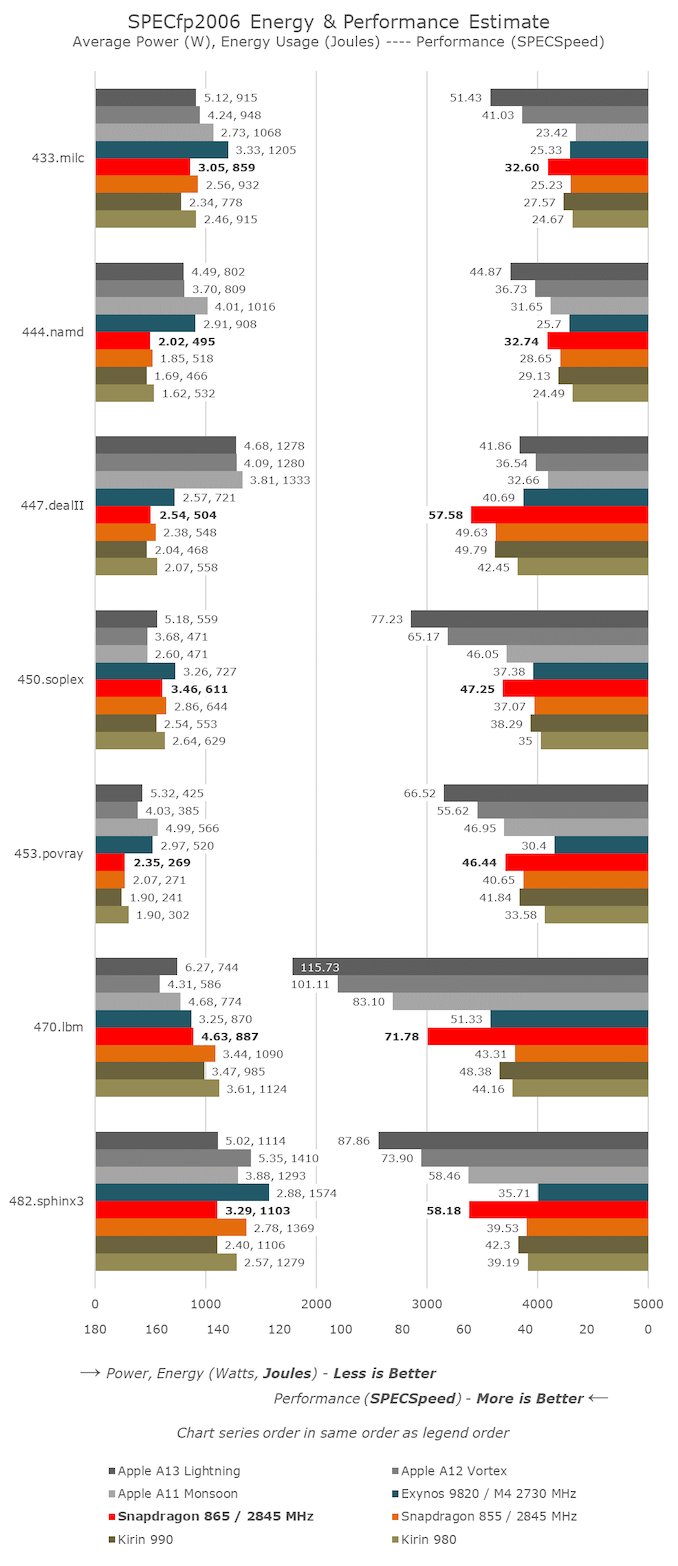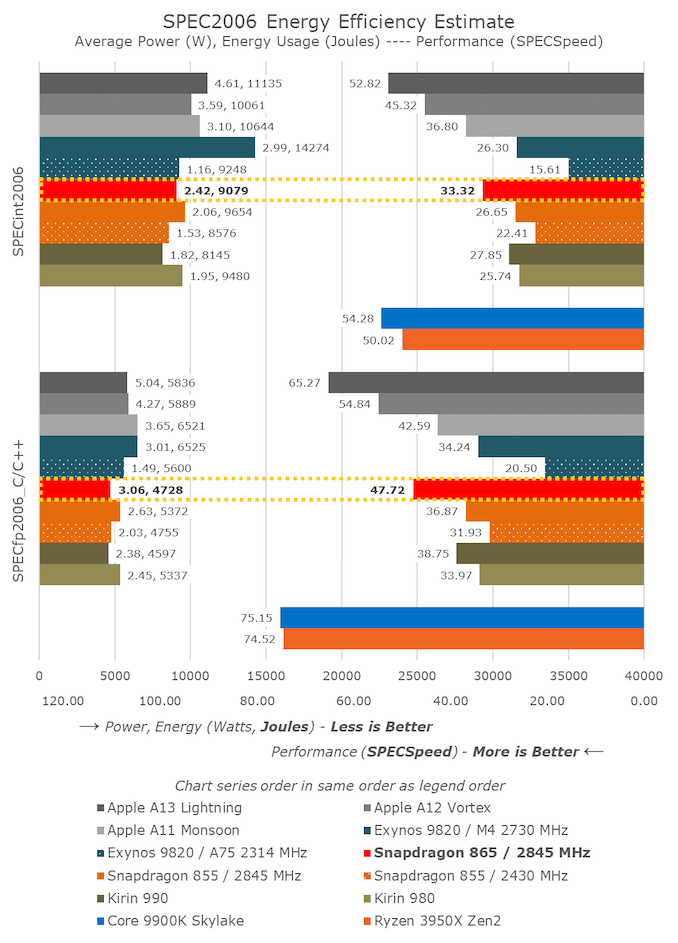The Snapdragon 865 Performance Preview: Setting the Stage for Flagship Android 2020
by Andrei Frumusanu on December 16, 2019 7:30 AM EST- Posted in
- Mobile
- Qualcomm
- Smartphones
- 5G
- Cortex A77
- Snapdragon 865
CPU Performance & Efficiency: SPEC2006
We’re moving on to SPEC2006, analysing the new single-threaded performance of the new Cortex-A77 cores. As the new CPU is running at the same clock as the A76-derived design of the Snapdragon 855, any improvements we’ll be seeing today are likely due to the IPC improvements of the core, the doubled L3 cache, as well as the enhancements to the memory controllers and memory subsystem of the chip.
Disclaimer About Power Figures Today:
The power figures presented today were captured using the same methodology we generally use on commercial devices, however this year we’ve noted a large discrepancy between figures reported by the QRD865’s fuel-gauge and the actual power consumption of the device. Generally, we’ve noted that there’s a discrepancy factor of roughly 3x. We’ve reached out to Qualcomm and they confirmed in a very quick testing that there’s a discrepancy of >2.5x. Furthermore, the QRD865 phones this year again suffered from excessive idle power figures of >1.3W.
I’ve attempted to compensate the data as best I could, however the figures published today are merely preliminary and of lower confidence than usual. For what it’s worth, last year, the QRD855 data was within 5% of the commercial phones’ measurements. We’ll be naturally re-testing everything once we get our hands on final commercial devices.
In the SPECint2006 suite, we’re seeing some noticeable performance improvements across the board, with some benchmarks posting some larger than expected increases. The biggest improvements are seen in the memory intensive workloads. 429.mcf is DRAM latency bound and sees a massive improvement of up to 46% compared to the Snapdragon 855.
What’s interesting to see is that some execution bound benchmarks such as 456.hmmer seeing a 28% upgrade. The A77 has an added 4th ALU which represents a 33% throughput increase in simple integer operations, which I don’t doubt is a major reason for the improvements seen here.
The improvements aren’t across the board, with 400.perlbench in particular seeing even a slight degradation for some reason. 403.gcc also saw a smaller 12% increase – it’s likely these benchmarks are bound by other aspects of the microarchitecture.
The power consumption and energy efficiency, if the numbers are correct, roughly match our expectations of the microarchitecture. Power has gone up with performance, but because of the higher performance and smaller runtime of the workloads, energy usage has remained roughly flat. Actually in several tests it’s actually improved in terms of efficiency when compared to the Snapdragon 855, but we’ll have to wait on commercial devices in order to make some definitive conclusions here.
In the SPECfp2006 suite, we’re seeing also seeing some very varied improvements. The biggest change happened to 470.lbm which has a very big hot loop and is memory bandwidth hungry. I think the A77’s new MOP-cache here would help a lot in regards to the instruction throughput, and the improved memory subsystem makes the massive 65% performance jump possible.
Arm actually had advertised IPC improvements of ~25% and ~35% for the int and FP suite of SPEC2006. On the int side, we’re indeed hitting 25% on the Snapdragon 865, compared to the S855, however on the FP side we’re a bit short as the increase falls in at around 29%. The performance increases here strongly depend on the SoC and particular on the memory subsystem, compared to the Kirin 990’s A76 implementation the increases here are only 20% and 24%, but HiSilicon’s chip also has a stronger memory subsystem which allows it to gain quite more performance over the A76’s in the S855.
The overall results for SPEC2006 are very good for the Snapdragon 865. Performance is exactly where Qualcomm advertised it would land at, and we’re seeing a 25% increase in SPECint2006 and a 29% in SPECfp2006. On the integer side, the A77 still trails Apple’s Monsoon cores in the A11, but the new Arm design now has been able to trounce it in the FP suite. We’re still a bit far away from the microarchitectures catching up to Apple’s latest designs, but if Arm keeps up this 25-30% yearly improvement rate, we should be getting there in a few more iterations.
The power and energy efficiency figures, again, taken with a grain of salt, are also very much in line with expectations. Power has slightly increased with performance this generation, however due to the performance increase, energy efficiency has remained relatively flat, or has even seen a slight improvement.














178 Comments
View All Comments
Bulat Ziganshin - Monday, December 16, 2019 - link
The Spec2006 tables show that A13 has performance similar to x86 desktop chips, which may be considered as revolution. Can you please add frequencies of the chips (both x86 and Apple) too, at least some estimations? Also, what are the memory configs (freq/CAS/...)? It will be also interesting to see x86 chips in individual SPEC benchmarks so we can analyze what are the weak and string points of Apple architecture.Andrei Frumusanu - Monday, December 16, 2019 - link
The Apple chips are running near their peak frequencies, with some subtests being slightly throttled due to power. The 9900K was at 5GHz, the 3950X at 4.6-4.65GHz, 3200CL16 on the desktop parts.I added the detailed overview over all chips; here's it again: https://images.anandtech.com/doci/15207/SPEC2006_o...
unclevagz - Monday, December 16, 2019 - link
It would be nice if some contemporary x86 laptop chips could be added to that list (Ryzen/Ice Lake/Coffee Lake...) just for ease of comparison between ARM and x86 mobile chips.sam_ - Monday, December 16, 2019 - link
Any strong reason for these tests being compiled with -mcpu=cortex-a53 on Android/Linux?One might expect for SoCs with 8.2 on all cores there may be some uplift from at least targeting cortex-a55, if not cortex-a75?
When you're expecting to run on a big core, forcing the compiler to target a in-order core which can only execute one ASIMD instruction per cycle seems likely to restrict the perf (unrolling insufficiently etc.). Certainly seems a bit unfair for aarch64 vs. x64 comparison, and probably makes the apple SoCs look better too (assuming XCode isn't targeting a LITTLE core by default). It also likely makes newer bigger cores look worse than they should vs. older cores with smaller OoO windows.
I get not wanting to target compilation to every CPU individually, but would be interesting to know how much of an effect this has; perhaps this could contribute to the expected IPC gains for FP not being achieved?
Andrei Frumusanu - Monday, December 16, 2019 - link
The tuning models only have very minor impact on the performance results. Whilst using the respective models for each µarch can give another 1-1.5% boost in some tests, as an overall average across all micro-architectures I found that giving the A53 model results in the highest performance. This is compared to not supplying any model at all, or using the common A57 model.The A55 model just points to the A53 scheduling model, so they're the same.
sam_ - Monday, December 16, 2019 - link
Hmm, I took a look at LLVM and the scheduling model is indeed the same for A53 and A55, but A55 should enable instruction generation for the various extensions introduced since v8.0. I can believe that for spec 2006 8.1 atomics/SQRDMLAH/fp16/dot product/etc. instructions don't get generated.It looks like not much attention has been paid to tweaking the LLVM backend for more recent big cores than A57, beyond getting the features right for instruction generation, so I can believe cortex-a53 still ends up within a couple of percent of more specific tuning. Probably means there's more work to be done on LLVM.
If it is easy to test I think it would be interesting to try cortex-a57, or maybe exynos-m4 tuning on a77 because these targets do seem to unroll more aggressively than other cortex-X targets with the current LLVM backend.
I made a toy example on godbolt: https://godbolt.org/z/8i9U5- , though for this particular loop I think a77 would have the vector integer MLA unit saturated with unroll by 2 (and is probably memory bound!), still the other targets would seem more predisposed to exposing instruction level parallelism.
Andrei Frumusanu - Tuesday, December 17, 2019 - link
I pointed out to Arm that there's not much optimisations going on in terms of the models, but they said that they're not putting a lot of effort into that, and instead trying to optimise the general Arm64 target.I tested the A57 targets in the past, I'll have a look again on things like the M4 tuning over the coming months as I finally get to port SPEC2017.
Quantumz0d - Monday, December 16, 2019 - link
Sigh another comment on the x86 vs A series. Why dont people understand running an x86 code on ARM will have a massive impact in performance ? How do people think a fanless BGA processor with sub 10W design beat an x86 in realworld just because it has Muh Benchwarrior ? There are so many possible workloads from SIMD, HT/SMT, ALU.Having scalability is also the key. Look at x86 AMD and Intel how they do it by making a Large Wafer and having multi SKUs with LGA/PGA (AM4) sockets allowing for maximum robustness.
ARM is all about efficiency and economical bandwidth and it won't scale like x86 for all workloads. If you add AVX its dead. And Freq scaling with HT/SMT. Add the TSMC N7 which is only fit for mobile SoCs. Ryzen don't scale much into clocks because of this limitation.
ARM is always Custom if you see as per Vendor. Its bad. Look at MediaTek trash no GPL policy. Huawei as well. Except QcommCAF and Exynos. Its a shame that TI OMAP left.
Andrei Frumusanu - Monday, December 16, 2019 - link
> Why dont people understand running an x86 code on ARM will have a massive impact in performance ?Nobody even mentioned anything regarding this, you're going off on a nonsensical rant yet again. For once, please keep the comments section level-headed.
Quantumz0d - Monday, December 16, 2019 - link
What ? Its a genuine point. ARM based 8c processors Windows machines like Surface Pro X can only emulate 32bit x86 code. 64bit isnt here and running both emulation will have am impact (slow) That's what I mean. They need native code to run and rival.Rant ? Benches = Realworld right. How come a user is able to see an OP7 Pro breeze through and not lag and offer shitty performance vs an iPhone ? I saw with my own OP3 downclocked on Sultan ROM due to the high clockspeed bug on 82x platform not just me, So many other users. GB score and benches do not only mean performance esp in ARM arena.
Except for bragging rights, This is pure Whiteknighting.